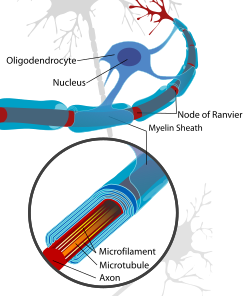Oligodendroglia
| Oligodendrocyte | |
|---|---|

Oligodendrocyte
|
|

Oligodendrocytes form the electrical insulation around the axons of CNS nerve cells.
|
|
| Details | |
| Identifiers | |
| Latin | oligodendrocytus |
| Code | TH H2.00.06.2.01018 |
| TH | H2.00.06.2.00003, H2.00.06.2.01018 |
|
Anatomical terminology
[]
|
|
Oligodendrocytes (from Greek, meaning cells with a few branches), or oligodendroglia, are a type of neuroglia. Their main functions are to provide support and insulation to axons in the central nervous system of some vertebrates, equivalent to the function performed by Schwann cells in the peripheral nervous system. Oligodendrocytes do this by creating the myelin sheath, which is 80% lipid and 20% protein. A single oligodendrocyte can extend its processes to 50 axons, wrapping approximately 1 μm of myelin sheath around each axon; Schwann cells, on the other hand, can wrap around only one axon. Each oligodendrocyte forms one segment of myelin for several adjacent axons.
Oligodendroglia, types of glial cells, arise during development from oligodendrocyte precursor cells, which can be identified by their expression of a number of antigens, including the ganglioside GD3, the NG2 chondroitin sulfate proteoglycan, and the platelet-derived growth factor-alpha receptor subunit (PDGF-alphaR). Most oligodendrocytes develop during embryogenesis and early postnatal life from restricted periventricular germinal regions.
Oligodendrocytes are found only in the central nervous system, which comprises the brain and spinal cord. These cells were originally thought to have been produced in the ventral neural tube; however, research now shows oligodendrocytes originate from the ventral ventricular zone of the embryonic spinal cord and possibly have some concentrations in the forebrain. They are the last cell type to be generated in the CNS.
Myelination is only prevalent in a few brain regions at birth and continues into adulthood. The entire process is not complete until about 25–30 years of age.
...
Wikipedia
